
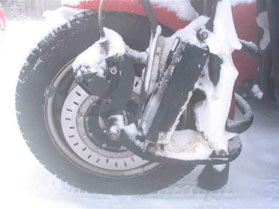
WINTER BIKE
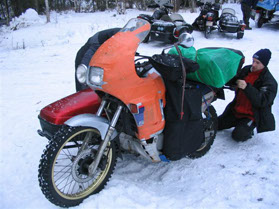
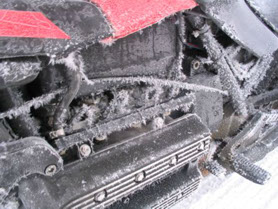
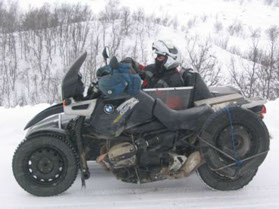
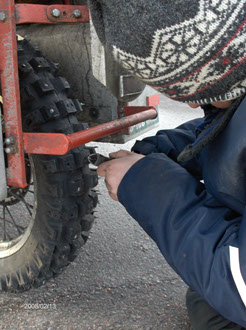
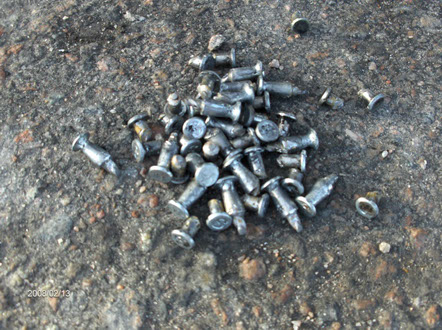

Some of the things mentioned below might raise an eyebrowe or make you laugh (and you will find they are in a total dis-organised braindump sequence) . For sure, we had good laughs as well going through gaining the experience...but be sure that we are indeed talking from experience.
- Driving over ice and snow: Take care... After the first few 100 clicks of carefull driving like your driving on eggs, you get into a state of "hey I can do this", where you increase your pace steadily, to a point where most of us drive like we drive on a dry summer road. We usually average at about 80-90 km / hr on snow&ice... looking ahead a lot, since sudden stops are not possible.... We found that the trick is to be on your bike with a sufficient amount of nonchalance and indifference...because it is just impossible to keep adrenaline running for hours at a stretch. At some point during the process, just as you are getting confident, you are likely to get into a spin of somesort...or disappear of the road in a cloud of snow...to get you back to reality.... it happened to the best of us. What you will not wear out are your brakepads... that is for sure - Drive safely !!
- As a winterbiker you MUST mentally prepare for your bike to take a serious (hopefully only) cosmetic pounding. Slightly more severe..at each winter trip we see a lot of tie wraps and duct tape being used...Winter biking is NOT a good thing for most bikes...it leads to spontanous desintegration of parts and electric functions of your bike. As long as these parts or functions are non-essential accessories you are ok. Extreme winter conditions seem for one reason or another not be in the design specification of our valued bike suppliers. Anyway the good news is that anything that stops working or falls of your bike and doesn´t impair the engine to run, your lights to work and brakes to function, is to be considered an unnecessary accessory away. You might notice that after a few years of winterbiking your wiring of your bike starts to spontaneously starts to disintegrate, and that (multi) connectors are the pits to have in multitude on your bike... as they usually suffer first... Take a soldring iron, cable and connectors with you to "hardwire" and "bridge" desintegrating wiring.
- Use your psychic and Zen skills and try to estimate which parts of your bike might break and would be extremely rare to find up north at a rendeer farm, and would force you to give up your trip for trivial reasons... good luck (you will find it also just the part that you did not have with you that breaks anyway, but it is worth a try..). Take replacements with you (throttle cable, clutch cable, bulbs, tire-pilot, bearing for your side car wheel...). By the way, I have seen very creative and extensive work being work or real wheel bearings, farings, tires etc, just to be able to continue the trip and not wait for automobile club assistance or give up. We have personally disassembled significant parts of our bikes in the snow, just to avoid having to call in the automobile club and give up...
- A full deck of tools and wrenches divied up between the rally participants (try to coordinated who takes what with him..) is of the essence. Hint: wear black gloves... that way you do not see how dirty they get inside from alsways having greasy hands going in them after a roadside repair.
- Horsepower is not of the essence when driving in the snow. High bred bikes with dyna-kits etc have an immense more difficult time coming to grips with cold starts and sub-zero driving. BMW (all models new, old and very old) dnjepr, mz, one cilinder off-roads have been observed to work very well in low temp conditions... of course there other bikes that work ok in winter condition, but mostly these circumstance do not seem to concern the engineers when they layout design conditions for the engines, wiring and electrical systems (including battery capacity and accessibility). We have lost quite a few bikes along the way and have witnessed spontaneous incineration of one bike upon return of the Älg rally !! The automobile club is your best friend.
- Beware of rendeer - if you see one there are at least 50 of them. Look for footmarks / tracks at the side of the roads as you are driving...The ones on the left side of the road will go to the right side and the ones on the right side to the left...occasionally you will see and indecisive one that keep runnig in front of you. Use your horn liberaly. Elk, moose, karibou or whatever you call them usually travel alone are rare to see... but are real big succers and slow... so be carefull.
- Make sure you have good coverage with your automobile club to repatriate your bike (just in case...). Also check medical assistance coverage in the country that you will visit (just in case).
- Beer does freeze when stored in your sidecar...cans do burst open if this happens...not a problem as long as everything stays frozen...hard liquor doesn´t. (basic hint.....). You will spot interesting behaviour in undercooled cans of beer or bottles of water... they will be liquid when closed, and as soon as you open them, they freeze up in one big lump of ice in a split second !!
- Spray your whole bike with S100 wax (except the brake disks :-) ). This somewhat (with emphasis on "somewhat") mitigates effect of sand, salt etc. Grease on areas that are supossed to keep moving (clutch, rear brake lever..) and protecting exposed areas below or at your bike are essential. To keep grease in place and prevent sand and salt to intrude, get creative with thick plastic flex material (welding screen material works well, since it is thick and can stand higher temperatures) and tie wraps. By the way--After the winter make sure you do not overdo the de-waxing and highpressure cleaning...blocked brakes, clutches, cables etc etc are frequently observered.
- Check the rating of your motor bikes dynamo/generator and beef up your battery to a big one. Regular car batteries are the real works... but you can overdo it in size, giving your electrical generator a hard time in keeping it charged (in which case your voltage drops, in which case your electronic ignition stops working... funny stuff..). Using two batteries (connected through a battery separating relais fi Cyrix 80/12, like used in boates and campers), ie one for your bike, and one for your heating equipment is a good option to invest in, prevents surprises in the morning, and keeps load on generator down, since only one battery is charged at a time. While driving be carefull with overdoing it on electric consumers... heated grips, extra lights, heated socks, heated visors have a tendency to suck even the biggest battery empty within a few hours. This especially happens on older bikes (K100, old boxers) that have a weaker generator (400-500W) and driving at 80km/h at low revs in top gear. A definite hint is to drive in a lower gear to rev up the engine and get more output from your dynamo. Also fully charging your battery in the evening is a good way to keep extra stress away from your generator. Believe me. me and my buddies have lived through a stuttering and completely electrical dead bike a few time before we figured out all this.
- Being able to easily remove the battery from your bike to take it inside at night is a real good thing to have. Get creative ! Very nifty designs of having a large battery in a side-suitcase, attached to outide of a sidecar or inside the sidecar have been spotted. The easier to remove and take inside the better. Just make sure to use large diameter cables to prevent voltage loss.
- Battery charger for on board accumulator ! Jump start cables ! make sure to have some with you.
- An extra canister of fuel. Having 10-15 liters of extra fuel in your side car is a sound strategy. Gasstations are not that sporadic in south an midde of nordic region, but higher up you only see one every 150-2300 km or so. Usually they are the place to hang out and center of activities in those regions... If you are on small roads and hit bad weather, you might have to turn around / make detours at inconvenient opening times for gas stations.
- An extra head light on your bike is a good thing. Up North days are very short and public lighting is not very popular. Also fun are the occasional trucks that you will encounter that have a whole array of huge lamps. You will feel like a rabbit being hunted and you buddy behind you sees you as being x-rayed. Best is to stop and wait for the pass...
- GSM phone with charged battery... to call 112... carry the phone on your body so it stays warm... (see "batteries" below")
- Batteries / electronic equipment: Carry (extra) batteries for your photo, film camera on your body to keep them warm. In the cold you will find out they either hold no power or you can film for 10 seconds... Same for flashlights...at very low temperatures in your sidecar you might be in for a surprise when you need it...
- Use thin oil SAE 5W"something" or 10-W"something" is ok for most cases. SAE 0W"something" is even better but exponentially more expensive. Watch out with SAE 0 in wetsump bikes where the clutch is also in that oil... you will usually have a very slippery clutch...
- If you have watercooling. Make sure to (re)fill it with coolant that can withstand -30 deg C (the lower the better...). Keep your radiator clean from sand and stuff... you can have your engine cooking at -20 if your radiator is blocked.
- If you adhere to above (ie big battery, thin oil, coolant), you are ok for most circumstances. Real nerds go further and put electrical 220 volt heaters in the oil sump or cooling circuits. Looks pretty cool and fuels good conversations up North. For more info on this "contact us".
- On some bikes it is good to put electrical heaters in the carburators. Especially when it is not that cold (+2C to -5C), carburators might freeze up due to dewpoint of watervapour in the air. Some bikes are more susceptable to this then others. In scandinavia additives to prevent condensation of water in the fuel are sold. Some bikes are more susceptable to this then others. (fuzzy advice ? Hey, you wanted some adventure he ?)
- Cover all "holes" (locks, tank filler cap etc) on your bike with tape whenever possible. Snow gets in everywhere...and its favourite hobby is to disable locks, keep caps and cases from opening etc. Btw, keep the little flask of lock defroster in your pocket...not in a case on your bike which might have a lock. (Duuh, get it ?). With my K-100 I have been driving around actually leaving the fuel cap lid open (ie not "clicked" to lock), since I got sick of fiddeling for 10 minutes at each gas stop...Covering your bike at night is recommended.
- Anything that has still a drop of water in it wil freeze up / block if your reach below -20C. This goes for throttle control cables, tank filler caps, electrical switches,helmet visor mechanics, rubber of side car hatch etc. This a particular funny dynamic if you come off the ferry in Norway at -10 having driven thorugh the rain for a long period through Germany....making sure vital things have been sprayed with silicon...Opening a sidecar cover with aged plastic side windows that need to fold (like on a EML boat) at ultra low temperatures (below -25) is a liability. You could hear "crraack" and your windows are in pieces...- To that extent - Any plastic will have a tendency to become very brittle at low (below -20C) temperatures. Trying to remove a side panel to inspect a carburator can result in breaking it in pieces. Avoid forcing stuck plastic controls and switches at low temperatures. Try lock defroster...and some deliberation. We have had the cap of a thermosbottle with hot tea inside being frozen up.. so we could not get to the hot tea...
- Prolongue your front wheel mud protector with some flex material (welding screen plastic works well) all the way to the ground. This prevents snow, stones, dirt etc getting slung onto your engines front. Funny to see overheated watercooled bikes at -20C, because radiator is blocked with snow... Same thing might be don at the back...more as a social gesture to your buddies driven behind you.
- If you are driving a side-car. Putting normal but real car winter tires (not the all weather stuff) on them is fine. Experience has proven that after a few winters the grip starts to fade, even though the tires might still have "plenty of profile". Go for safety... You will develop a sence of gradations of "slippery" very fast when you are driving.. there is normal slippery, bad slippery and insane slippery. If you drive with someone in your sidecar (ie not only carry the normal 20kg of beer as deadweight, but real heavy biker-deadweight), you will need spike tires. These are available at normal car shops for very moderate prices. When you return to the continent, you can pretty easily (with some skill and determination and a side-cutter) remove the spikes while waiting for the ferry or on it.
- If you drive solo you definitely need studs / spikes. Best is to get a pair / reserve a pair of tires and coming off the ferry go to a bike shop to have them changed. Good thing is of course to look on the internet and make arrangements before. Again, coming back you can remove them with a side cutter.
- Take a shovel with you (foldable ones from military dumps shop are fine). Don´t ask why. Every winter biker will find out sooner or later...
- Towing line... your buddies or nordic car drivers may have to come to rescue due to having to get out of the snow (see "shovel" above) or due to bike malfunctioning.
- A few reels of Duct tape are a good companion. Although at very low temperatures you will be surpised to notice that nothing sticks anymore - tie wraps are your best friend.....
- Tie wraps....winter biker best friends. As with the shovel, you will find out their use sooner or later.